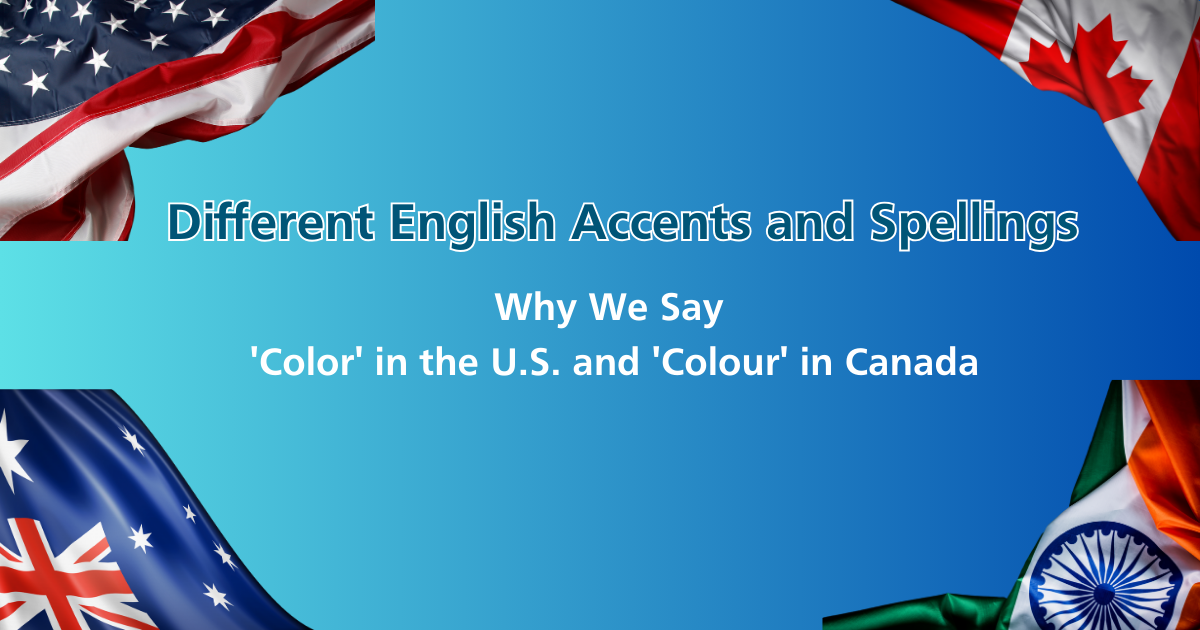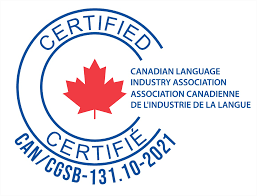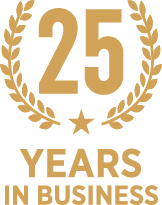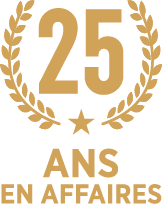English is everywhere—spoken by over a billion people in nearly every corner of the globe. But here’s a fun twist: depending on where you are, English might look or sound quite different. Ever puzzled over the differences between “cookies” and “biscuits” or why Americans have “color” while Canadians stick with “colour”?
Out of the global population of around 7.8 billion, roughly 1.35 billion people communicate daily in English. Interestingly, most aren’t native speakers—only about 360 million have English as their mother tongue. Chinese is the most widely spoken first language, with Spanish coming next and English ranking third. While English leads in the number of speakers, it also dominates as the most popular second language to learn worldwide, with French trailing as the second most studied.
Same Language, Different Words
One of the most interesting aspects of English is how different regions have developed their own unique vocabulary. Here are some examples that highlight these variations:
U.S. vs. U.K.
- Vacation (U.S.) vs. Holiday (U.K.)
- Flashlight (U.S.) vs. Torch (U.K.)
- Diaper (U.S.) vs. Nappy (U.K.)
- Sneakers (U.S.) vs. Trainers (U.K.)
- Truck (U.S.) vs. Lorry (U.K.)
Australia
- Maccas for McDonald’s
- Bogan for an unsophisticated person (kind of like “redneck” in the U.S.)
- Esky for a cooler or an ice box
- Thongs for flip-flops (not underwear!)
- Servo for a gas station or service station
India
- Out of station for being out of town
- Pass out for graduating (e.g., “He passed out of college last year.”)
- Lakh and crore for 100,000 and 10 million, respectively
- Petrol pump for a gas station
South Africa
- Robot for Traffic light
- Braai for Barbecue or grill
- Just now for an unspecified time in the near future (soon, later, or eventually)
- Bakkie for Pickup truck
Nigeria
- K-leg for A complicated or problematic situation
- Chop for To eat or consume
- Ehen! for Exclamation used for surprise, agreement, or realization
- Long-leg for Someone with influential connections
Ireland
- Craic for Fun, entertainment, or enjoyable conversation.
- Brogue for a strong Irish accent.
- Gobshite for a foolish or stupid person.
- Jacks for Restroom or toilet.
- Grand for Fine or okay; often used to express satisfaction.
Accents: The Sound of Diversity
Factors like migration, isolation, and cultural exchange shape accents. For instance:
- Australian English: Despite its British origins, the Australian accent developed uniquely due to the mixing of British regional accents among early settlers and the influence of Indigenous languages. Australians love to shorten words. Afternoon becomes “arvo,” breakfast becomes “brekkie,” and relatives are “rellies.”
- Indian English: Strongly influenced by British English during colonial rule, Indian English retains some archaic British pronunciations but has also been shaped by borrowing words and syntax from native Indian languages like Hindi and Tamil, making it distinctive and instantly recognizable. For instance, the “v” and “w” sounds are often swapped, so “wet” may sound like “vet.” Popular phrases like “I will revert” (for “I’ll get back to you”) also showcase its distinctiveness.
- A fun twist: What does a Canadian or American accent sound like to an Indian ear? Often described as “flat” or “neutral,” these accents stand out against the sing-song rhythm of many Indian languages.
- Canadian English: Canadians blend British and American elements. Accents in Canada, especially in regions like Newfoundland, reflect Irish and Scottish influences.
- British English: Received Pronunciation (RP), often called “the Queen’s English,” is the most recognizable British accent. But did you know there are dozens of regional accents, like Scouse (Liverpool), Geordie (Newcastle), and Cockney (London)?
- American English: American spelling changes were partly an act of rebellion. In the early 1800s, Noah Webster, the man behind Webster’s Dictionary, decided to simplify spellings to make them uniquely American. His changes included:
- Dropping the “u” in words like “colour” and “honour”
- Changing “-ise” to “-ize” (e.g., “realize” instead of “realise”)
Webster’s goal was to make American English straightforward and distinct from its British counterpart—essentially spelling with a patriotic twist.
English Variations in the Written Word: the Story of English Spelling
Spelling is another area where English diverges. Much of this stems from two key dictionaries:
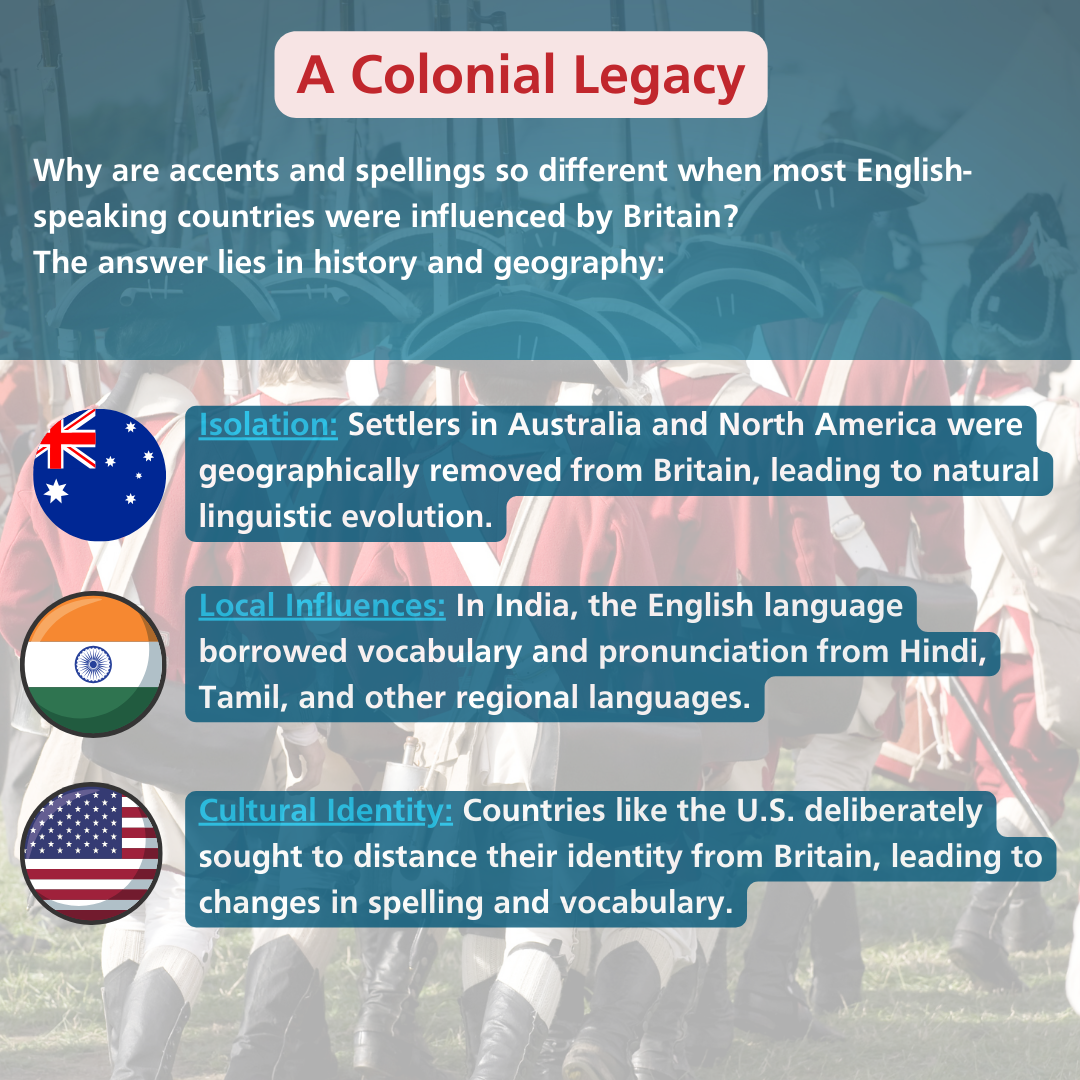
- The Oxford Dictionary: Rooted in the British tradition, this dictionary standardized British spellings like “colour” and “favour.”
- Webster’s Dictionary: Noah Webster, an American lexicographer, simplified spellings to reflect pronunciation and promote national identity. Thus, “colour” became “color” and “favour” became “favor.”
Interestingly, Canadian English often straddles both systems. Canadians write “colour” and “centre” but may lean toward American terms like “program” over “programme.”
Canada’s Unique Approach:
Canadian spelling strikes a balance between British and American norms. For example:
- Canadians spell “colour” and “centre” in the British style.
- However, they often use American forms like “program” instead of “programme.”
- Canadians also mix styles, writing “cheques” (British) but adopting “organize” with a “z” (American).
Canadian Spelling’s Evolution:
In the late 19th century, Canada’s first Prime Minister, Sir John A. Macdonald, upheld British spelling standards for government documents. However, over time, American influences seeped into Canadian English. For instance:
- Canadians now prefer “organize” over “organise.”
- Words like “encyclopedia” use the American spelling rather than the British “encyclopaedia.”
Practical Tips for Localized English Content
When writing for a global audience, it’s important to adapt to local conventions. Here’s how:
- Identify Your Audience: Are you writing for Canadians, Americans, or Australians? Knowing this helps set the tone.
- Use Localization Tools: Platforms like Microsoft Word and Grammarly allow you to select specific English variants.
- Consult Style Guides: Guides like the Chicago Manual of Style (U.S.), Gage Canadian Dictionary and The Canadian Style, or The Guardian Style Guide (U.K.) are invaluable.
- Hire Language Professionals: Language service providers ensure content is tailored to the right audience, whether adapting spelling, tone, or cultural nuances.
The variations in English aren’t just fascinating—they’re a gateway to building stronger connections with your audience. Whether it’s understanding local slang, adapting spelling, or striking the right tone, tailoring your communication shows you truly understand your audience’s needs and culture.

